Paul Atkinson: An Interview
Paul Atkinson began his professional career with Oldham Athletic, making a goalscoring debut in August 1979. He was called up to the England under-21 squad before moving to Watford for £175,000 (a fee set by tribunal) in summer 1983. He suffered a broken ankle in his first pre-season game, which hampered his progress in the First Division but later made a substitute appearance in the 1984 FA Cup Final. Paul returned to Boundary Park in 1985 for three seasons during which he had loan spells with Swansea and Bolton. In summer 1988 he moved to Burnley, spending two seasons at Turf Moor before injury forced him to retire from the Football League at the age of 28.
His father Charlie played professionally for Hull City and both Bradford clubs, remaining the record league appearance holder for Park Avenue. Paul has continued to be involved in the game after retiring from playing, working in a coaching capacity for the Leeds United Foundation, and as technical director at the club’s Girls Centre of Excellence. I had the opportunity to ask him about his career, memories and highlights.
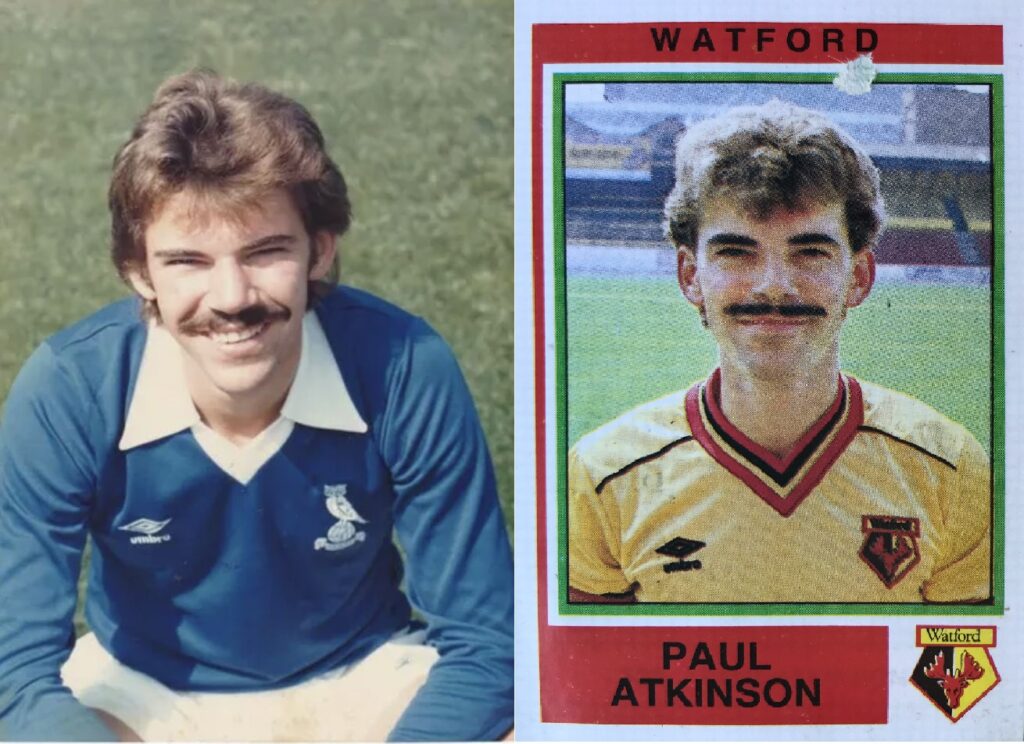
What are your earliest football memories?
I remember watching my first FA Cup, it was a team I liked at the time, Everton and West Brom [1968] – when you’re young, you remember finals. A little bit later on, I remember the Leeds team when they played Celtic in the European Cup, it was the semi-final second leg [1970]. I used to go to bed early if there was a game like that, and my dad would wake me up to watch the highlights – then I would go back to bed. They lost at Celtic. I remember Man United playing in the European Cup, 1968, don’t really remember the 1966 World Cup, so it’s around that time, being 7-ish that my first memories of watching football are from.
Having been a professional himself, how much of an influence was your dad?
He was a bookie when he finished, he was a turf accountant but he didn’t have a great amount of time, Saturdays were always taken up so they were night matches that we’d go to. He’d played at Bradford Park Avenue, and in about 1970 they fell into non-league, I went to one or two night matches with him. He was a big influence – dads who’ve been footballers tend to be quite tough on their sons; he’d always tell me how it was!
When did you start going to games regularly?
I remember going in the Boys’ Pen at Leeds, I played for Pudsey Juniors team. Cyril Partridge – I think he was a physio/trainer at Leeds – his son played with me and so he used to get us into the Boys’ Pen. I was going to Leeds matches the season they won the league, 1973/74, then when Brian Clough came in for a few days – but that next season they were in the European Cup, I went to the semi-final against Barcelona with my dad – I remember that.
What was your route into professional football at Oldham Athletic?
I played for Leeds City Boys and Yorkshire Schoolboys, but I didn’t sign on anywhere as a schoolboy – my dad said they took on so many it wasn’t worth it, so I hung on. There were a few clubs interested. I’d had a groin injury and had to wait but then I played in a trial, only lasted 45 minutes, and Colin McDonald [Oldham scout/trainer] recommended me, I signed and it went from there.
They didn’t actually have a youth coach at the time, it was Andy Lochhead, first-team coach, who’d take us, Jimmy Frizzell the manager didn’t come out at all, but then around Christmas-time Billy Urmson came in as youth coach. There weren’t that many coaches at the club, sometimes it was left to a pro who was out of the first-team picture to take us, I remember David Shaw, who was coming up to retirement, taking a session. Later on, Bill Taylor, who’d worked with England, came in.
I was doing alright and had got close to the first team – I went down to Crystal Palace as 13th man, and then pre-season 1979, I played in the Anglo-Scottish Cup against Bury. It was more like a friendly really but still a first-team match, and then we went up to Newcastle for the opening game and I started [scoring after five minutes]. I played the first three games and then got injured at Northampton in the League Cup, but got back in the side for the rest of that season.
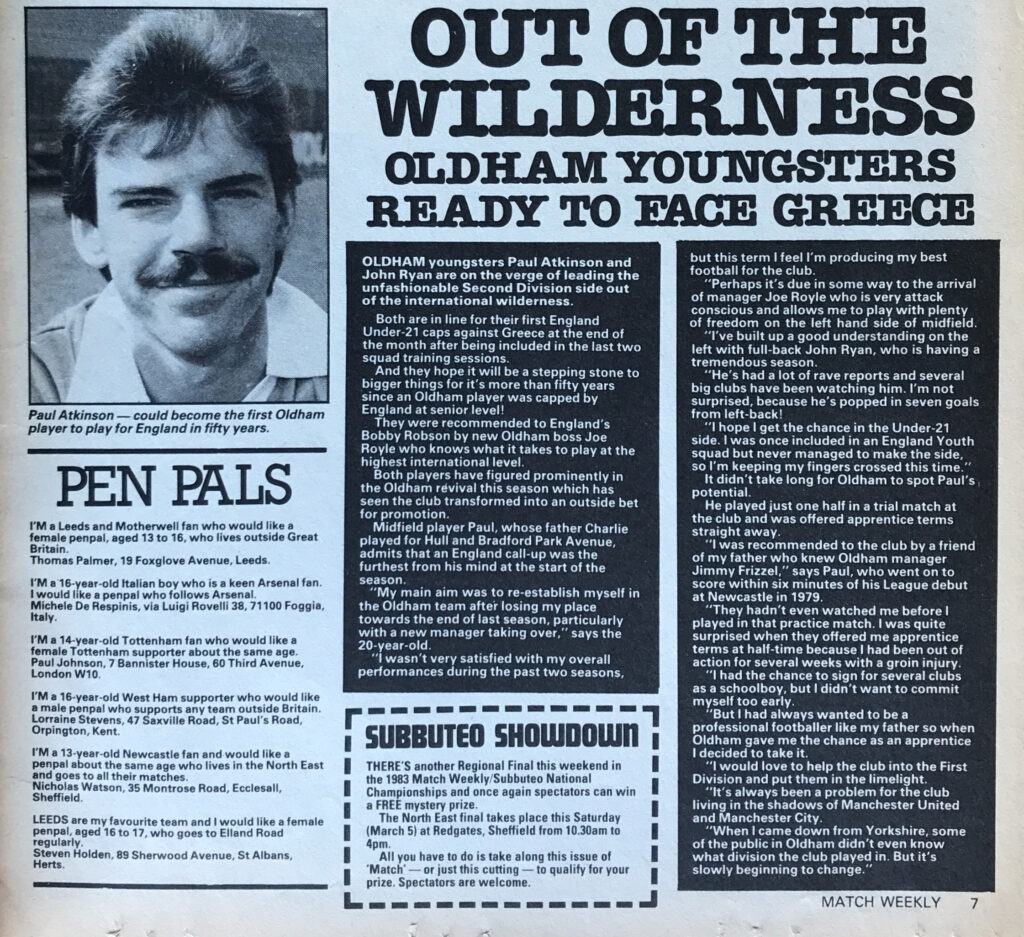
Paul Atkinson in Match Weekly, 1983
What was it like at that time for a young player in the Football League, much more physical than now?
It was, but that was what we were used to, really. The only thing was, Oldham reserves were in the Lancashire League, and there were only a couple of league teams with reserve sides in it, Port Vale and maybe another, so it was a step up from that to the first team. I would say that in the 80s most teams lined up 4-4-2 and the two central midfield players were directly in opposition, more or less to stop their opposite number playing, whereas now they’re playing a different shape, trying to break the lines, so you don’t get that direct physical challenge as much.
It makes me laugh when they show the 1970 FA Cup Final, Chelsea v Leeds, and they look at it with VAR, referee it by today’s standards – they reckon there would only be about three players left on the pitch!
Those early days at Oldham, you got into the first team and stayed there?
I had a really good first season, I got into the England Youth squad for a game, I went to Denmark with them but I didn’t play. The Youth benchmark, there were a lot of players who were in the Second Division so they were already playing [first-team football] or if they were in the First Division, they had already made their debuts. You had better opportunities then because we didn’t have the foreign players and staff. Good players, young players, if they thought you were good enough you got a chance. So for me to get into that squad with players who were already playing first-team football, even at under-18 level, I don’t think you’d get that now.
It was a good first season, and there were a few clubs interested, they said Liverpool had offered £300,00 for me and Oldham turned it down because they wanted £350,000. [How would you have felt about that?] I would have definitely gone, but I think at the time, Liverpool were buying young players who weren’t necessarily going there to play [in the first team] and I would have felt that I wanted to play as I’d only had one season of league football. At the same time, I know I wouldn’t have turned it down and my dad would have said that you have to take those opportunities. It was the same summer that they signed Ian Rush, so they were having a little bit of a splurge on young players. I didn’t hear about it until partway through the next season, when I wasn’t playing as well, so I don’t know if that triggered it!
How did you find being involved with the England under-21 squad?
I went and trained with them, I think John Ryan got a cap [v Hungary in 1983]. I know Andy Goram was due to play, I remember they were playing at Portsmouth and they ended up bringing in the Portsmouth goalkeeper [Alan Knight], that’s how the story goes. I think it was Howard Wilkinson in charge when I trained and we had games against Arsenal in a friendly on a training camp but a bit like the under-18s, I was on the fringe but I didn’t play. When I went to Watford, they put my name forward but I broke my ankle so it didn’t go well so far as getting that opportunity.
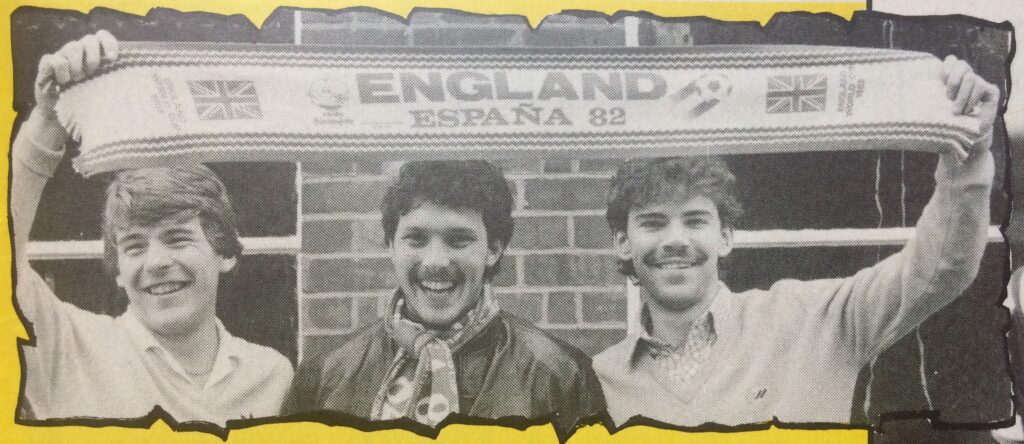
Paul Atkinson (R), with Andy Goram & John Ryan outside Boundary Park, 1983
How did your move to Watford come about in 1983?
I was going into the last year of my contract and wanted to keep my options open, I’d been around the England under-21s [with team-mates Andy Goram and John Ryan]. Oldham made me an offer that wasn’t so great financially. I actually spoke to Brian Clough, he hadn’t seen me play, he said he’d had good reports about me but I wasn’t sure about that – he also didn’t want to go to tribunal. He rang me at home once and spoke to my mum, she said she couldn’t get him off the phone, he was talking to her about cricket for half an hour! Newcastle were interested as well, they were still in the Second Division, so I had a few options but I went down to Watford. I didn’t have an agent, that mainly came into the game a little bit later on.
How did you find your stay there under Graham Taylor?
They’d just finished second in the First Division and I think that direct style took the First Division by surprise, really. Luther Blissett had gone to Italy, so Graham wanted to play John Barnes up front and I’d fit in his place on the left-hand side. They had a different style, very direct I suppose, based on statistics, and the wide players didn’t have any defensive duties at all. Also, I wasn’t really an all-out winger, at Oldham I’d play on the left but as a midfielder, not always hugging the touchline, so it was a different role. Unfortunately I broke my ankle in pre-season – Mo Johnston came in and he played up front with George Reilly so John Barnes came back on the left.
What was it like to be involved in the FA Cup Final, when it was still the biggest occasion in English football?
It was obviously a massive game then, last match of the season which it isn’t even always now, I’d grown up watching it. I wasn’t really nervous – if you’re not starting it’s not exactly the same. Watford didn’t really play well though and Everton were obviously the better team.
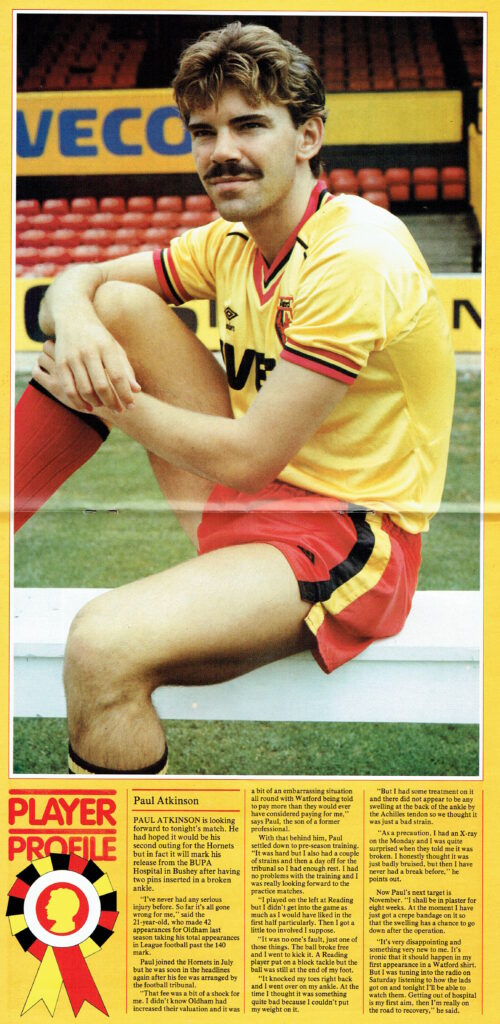
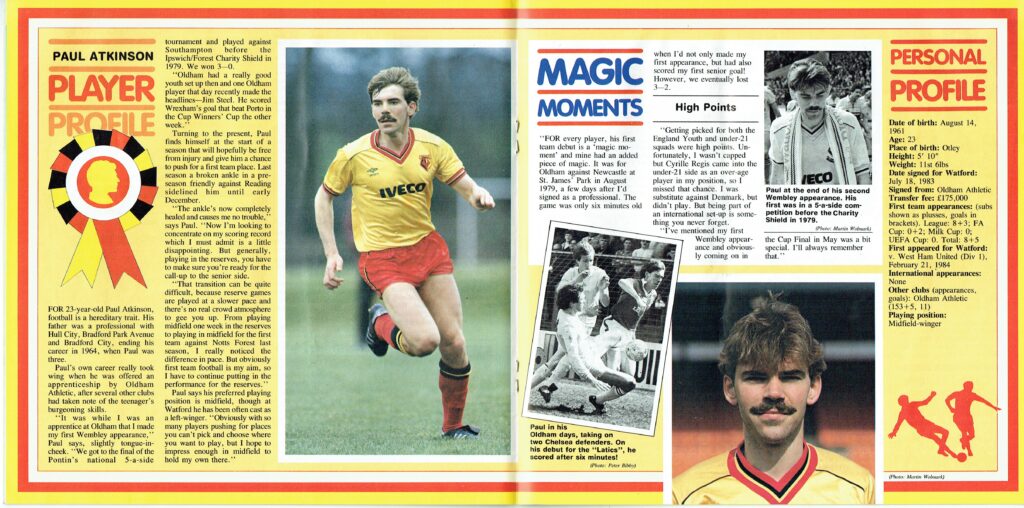
How was your second spell back at Oldham?
I had a few injuries, and I’d say that’s one of the disappointments of my career, that I never really got back to my best form and didn’t really do myself justice in that second spell at Oldham. I went out on loan a couple of times, never got back to my best level.
Do you think your career would have been extended in the current era by better facilities and pitches, and a more scientific approach to the treatment of injuries?
I think so. For example, Bill Hails at Watford, he wasn’t actually a fully qualified physio; Graham Taylor had told him if he did a course at Lilleshall – it might have only been a two-week course – he’d have a job at Watford. They had Bertie Mee, who’d been Arsenal manager, coaching, as he was a fully qualified physio he kept an eye on things. Nowadays they’re so well looked after, everything’s monitored, all scientific, based on statistics – measuring how far they run even in training. A few players back in my days wouldn’t have liked it, they saved themselves for Saturdays, but there’s no hiding now.
Over the course of your career, who were the best players you played with and against?
One of my favourite players I’d watched at Leeds in the late 70s, Tony Currie, he was a great footballer, and I played against him for Oldham at QPR. I was stood next to him and thinking, ‘I’ve watched you play’, it was a memorable moment. As for team-mates, John Barnes really stands out, he was built like a middleweight boxer but so light on his feet. He’d be in the gym with us at Watford, he was like a matador, we couldn’t get the ball off him. So he’d be the best player I ever played with, head and shoulders above.
The pitches you played on were often very different to today’s – did you feel you had to adapt your game for the worst surfaces?
Again, it was what we were used to, whether it was a mud-bath or rock-hard. I remember one game at Boundary Park, it was on TV against Watford, maybe in mid-April and the pitch was really rough and cut-up. I was going to put in a cross and it took a bobble, it actually ended up being a really good cross because of the bobble! Players don’t really have to deal with that today, adapt to different conditions, from youth level the surfaces are like carpets.
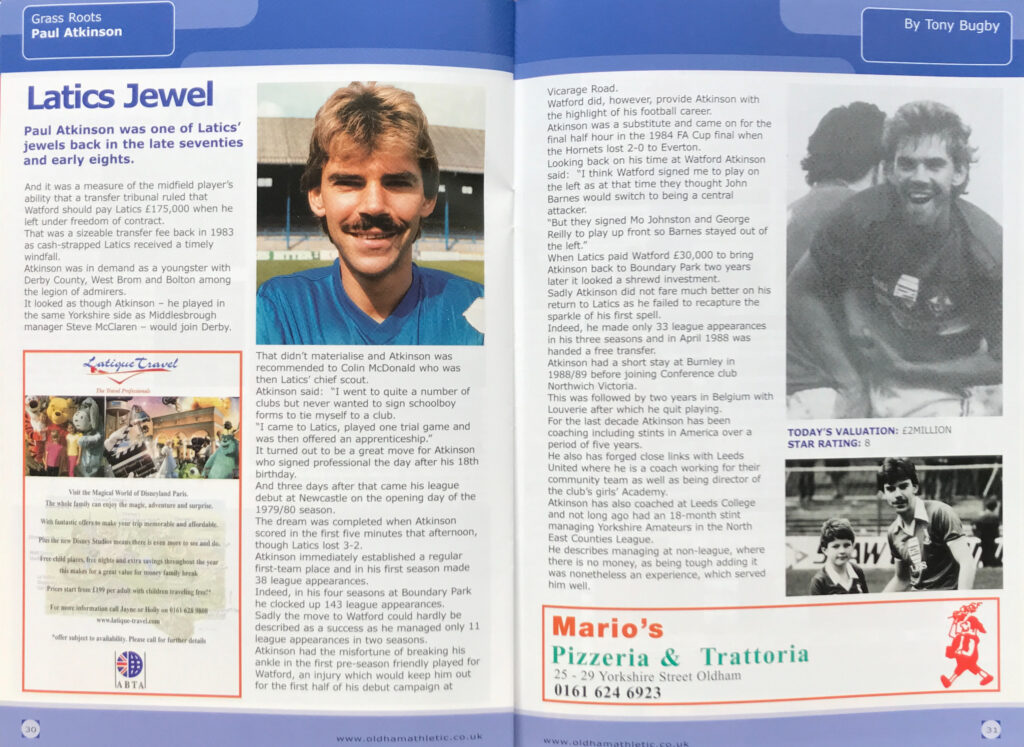
Paul Atkinson, ‘Latics Jewel’ (match programme, 2002)
From the apprenticeship you had to the way players come through the academies now, what has changed for young players?
There’s so much competition, so few of them actually make it and it’s difficult for them when they have to drop down the leagues, maybe to non-league. I think it’s harder for young players from the academies to adapt sometimes, they’re coached in a much more technical way. Jamaal Lascelles said that going on loan to Stevenage was the making of him, playing against players whose mortgages depended on it, really playing for a living, much more physical than he was used to.
Then they’re competing against all the foreign players that come in now, we didn’t really have to deal with that. A few youth players came through with me at Oldham, there was only one foreign player, Ryszard Kowenicki [from Poland].
Of the managers who you worked with, who stood out for you?
I think Joe Royle was the best, a player’s manager – Graham Taylor had a lot of success with his system, which was difficult to play against for a lot of teams. It was 4-2-4 and you were playing as a wide player, you didn’t have to cover your own full-back, your only defensive responsibility would be your opponent’s full-back. So that was a direct sort of game, and they coached within that system – whereas now, it’s playing through midfield, it was very much back to front, play off the striker, get it wide and get crosses in. It was basic, but it was hard to defend against when it was working well.
What did you make of Graham Taylor’s time as England manager?
He did say, because he’d been at Aston Villa, that the style had changed a bit, but he did pick players – Geoff Thomas from Crystal Palace, Carlton Palmer – who were very much from that system of up-and-down midfield players. He probably went against some of his principles with England, that he’d had as a club manager, he obviously felt he couldn’t do that with England. The stick he would have got from playing that way would probably have been too much. I don’t think he was a good fit – if you’ve seen the documentary [An Impossible Job], it’s hard to imagine that happening nowadays with Pep Guardiola… He had a lot of success, and managers are judged by that; he had a system that suited some players – but not others.
What did players think about the Panini sticker albums?
I remember seeing them about and they might have a joke, you know if someone had a bad haircut. It’d be more a mickey-take than anything.
Do you remember Panini 84, when you were mixed-up with George Reilly?
I’ve seen it since! I remember seeing it on eBay, and thinking it was a bit of a strange occurrence. [It might be worth a bit now!]
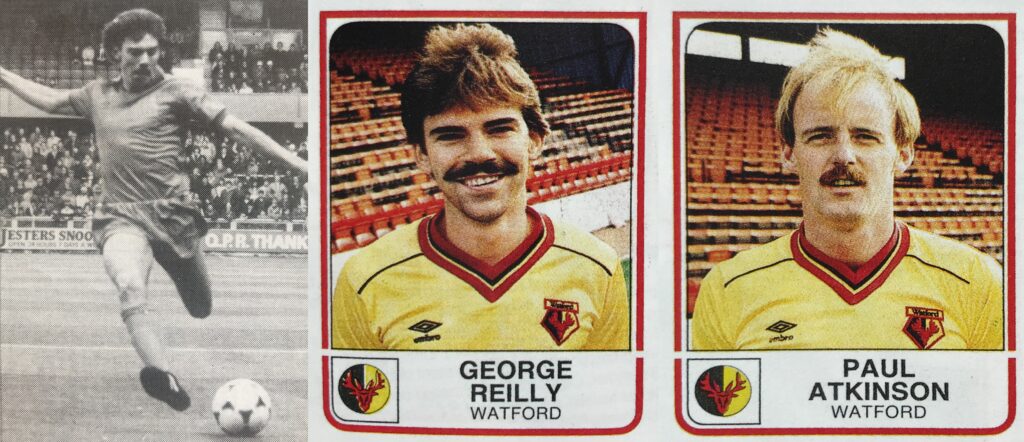
Paul Atkinson of Oldham Athletic & mixed up with George Reilly in Panini Football 84
As a player, you’d be used to playing 50 games a season – how do you think you’d have felt about squad rotation, dropping in and out?
I wouldn’t have particularly liked it, I don’t think, you get into a rhythm of playing. I know some of these clubs that are playing in Europe, they have to rotate players, but I always found if you go more than a week without a game, it just doesn’t feel right. I remember my first season at Oldham, and they were struggling going into the Easter programme – they always used to play Blackburn on Easter Friday, and this one they won by a lot of goals, I think 5-0. On the Saturday they had another game which they drew [0-0 at Notts County] and then on the Monday they had another game – and they played the same team, same 11, in all three games; Friday, Saturday, Monday.
Another major change is the grounds themselves, as a player how conscious were you of the crowd noise, the atmosphere from the terraces?
When I was at Oldham, it would only be 5-7,000, but when we played at West Ham, the crowd was right on top of you. 25,000 for their home matches so you do really feel that atmosphere and I think that brings out your best – I remember playing there when West Ham were top of the league and managing a draw there against the odds. I do think it helps you, gives you a little more edge when there’s such a big crowd.
When crowds were down in the 70s and 80s, it was a different time for football?
When I was watching in the late 70s and Leeds were going off, especially towards the end of the season if there was nothing to play for, you’d see less than 20,000 – even in Division One, 17/18,000. Elland Road half-empty, it’s a big difference when you’re down to those crowds.
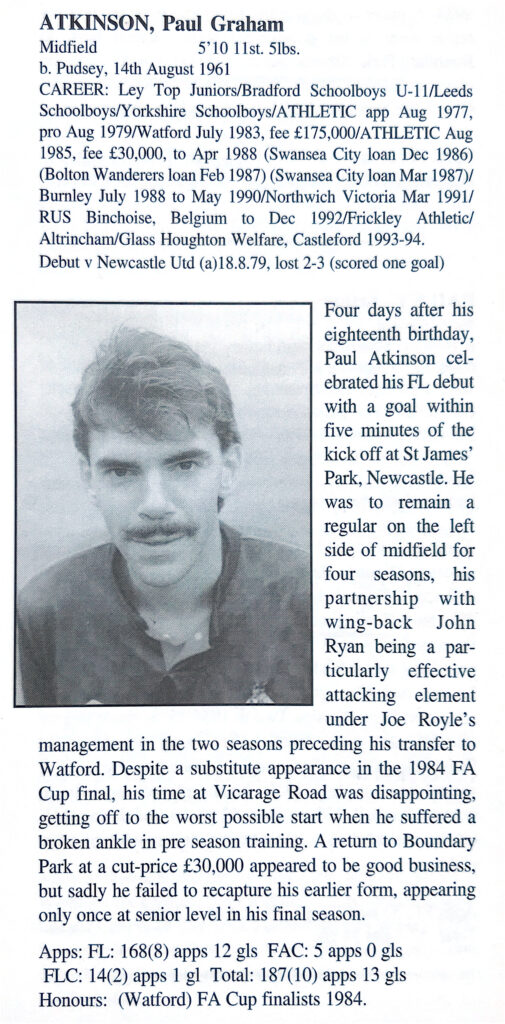
What were your most memorable experiences as a professional footballer? Could you pick a highlight of your career?
My highlight would be playing in the FA Cup Final – individually, I suppose when I did get called up for the under-18s, under-21s, it’s recognition. Those are always the highlights, two of my best seasons were my first, and the last season of my first spell at Oldham before I left. I would look back on them, in those seasons I was injury-free as well so I played pretty much all the games.
What’s your current involvement and interest in the game – would you say you still have the same passion as when you started out?
I’ve been coaching at the Leeds United Foundation for 28 years, I’ve done that for quite some time, I think I’m the longest-serving member of staff there, always part-time. It’s been a long time, because I’ve not been full time I’ve been able to do other coaching as well, and other work. I’ve put on sessions at schools, camps in the school holidays, technical director of Leeds United Girls Regional Academy and I’ve done that for about 15 years now. I still love the game, I don’t think that’ll ever change.
Do you still watch Leeds?
I see all the home games, I get tickets from the Foundation – they’ve been pretty good to us, when they had the promotion parade, I got on the third bus! I also watch my son, wherever he plays. He’s played non-league and he’s looking to get back up the ladder.
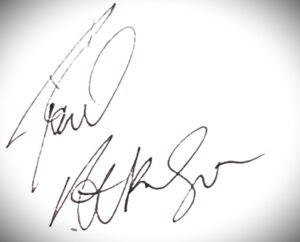
Paul Atkinson’s autograph (from 1985)
Watford player profiles courtesy of the Old Watford website.
Many thanks to Mick Appleby for his help in arranging this interview, and to Paul Atkinson for kindly taking the time to answer my questions.